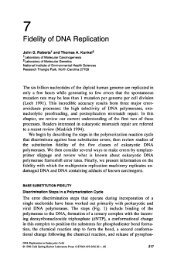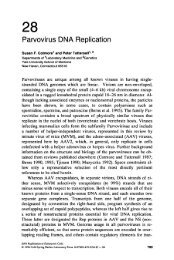Chapter 39: Mitochondrial DNA Replication (PDF)
Chapter 39: Mitochondrial DNA Replication (PDF)
Chapter 39: Mitochondrial DNA Replication (PDF)
Create successful ePaper yourself
Turn your PDF publications into a flip-book with our unique Google optimized e-Paper software.
<strong>Mitochondrial</strong> <strong>DNA</strong> <strong>Replication</strong> 1023<br />
)QOOOOOOOOOOOOOOOOC<br />
n i<br />
Transcription<br />
ooaxxx><br />
ooooooc<br />
R-loop formation<br />
OCX.<br />
Figure 2 Diagram illustrating formation of a persistent RNA-<strong>DNA</strong> hybrid via<br />
transcription at the leading-strand origin. Roman numerals represent CSBIII,<br />
CSBII, and CSBI, respectively. The gray filled oval represents the mtRNA<br />
polymerase complex.<br />
that have been employed for the mammalian systems, where the rate of<br />
replication is slow and where, in retrospect, the mode of replication<br />
(unidirectional synthesis from two widely spaced origins) has advantaged<br />
these studies.<br />
Another issue is the aggressive rate of recombination in the fungal<br />
mt<strong>DNA</strong> systems, in contrast to mammals, where mt<strong>DNA</strong>-recombination<br />
is at most a rare occurrence. Therefore, the problem of distinguishing between<br />
replication and recombination events is acute for yeast and essentially<br />
nonexistent for mammals. Finally, the small closed circular form of<br />
mammalian mt<strong>DNA</strong>s and a less aggressive background of nucleases<br />
have facilitated isolation of intact genomes.<br />
Some parallels may exist between the yeast and mammalian systems.<br />
Very recent cloning efforts point to homologs between transcription,<br />
replication, and accessory protein sequences. Putative origin sequences<br />
in yeast have some conserved elements in common with mammals, and<br />
these possible shared features have been reviewed in detail previously<br />
(Schmitt and Clayton 1993). However, it is likely that yeast mt<strong>DNA</strong> can<br />
be propagated by multiple mechanisms, at least one of which is a rolling<br />
circle (Maleszka et al. 1991).<br />
CONCLUSIONS AND PROSPECTS<br />
The overall mode of mammalian mt<strong>DNA</strong> replication has been known for<br />
some time. During the last decade, the nature of both cis- and trans-






